MIDI History Chapter 7- MIDI Associations (1983-1985)
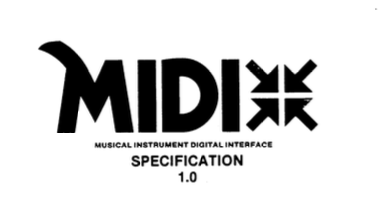
MIDI in 1983 – It seems to work, but what’s next?
In Chapter 6 of the History of MIDI, we started in 1981 when Kakehashi-san first went to Tom Oberheim with the idea of a standard for synthesizer control and finished that chapter with the first public demonstration of MIDI at the 1983 NAMM show.
We also updated this article in December of 2024 to further highlight the contributions of 2025 MIDI Association Lifetime Achievement award recipients John Bowen, Karl Hirano, Tadao Kikumoto, Tetsuo Nishimoto, Chris Meyer, Jeff Rona and Brian Vincik to the early development of MIDI.
John Bowen, head of sound design for Sequential had recounted that he had been busy finishing the presets for the Prophet 600 and that although Sequential had tested the Prophet 600’s MIDI connecting to another Prophet 600, they really had no idea if it would work when they connected it to the Roland Jupiter 6. But it did and everybody was pretty amazed.
We also documented that in 1983, there were only 5 companies working on MIDI- Sequential Circuits, Kawai, Korg, Roland and Yamaha. That is pretty easy to confirm because here are the SysEx IDs in the Prophet 600 manual from December of 1982.

In Chapter 6 we also introduced a lot of the key players involved with MIDI including MIDI Association Lifetime Achievement recipients John Bowen, Karl Hirano, Ikutaro Kakehashi, Tsutomu Katoh, Tadao Kikumoto, Bob Moog, Tetsuo Nishimoto, Tom Oberheim, Chris Meyer, Jeff Rona, Dave Rossum, Dave Smith and Brian Vincik.
The original MIDI 1.0 Specification was written by companies collaborating outside of any organization, and though different entities with different acronyms (the Japanese MIDI Standard Committee or JMSC, The MIDI Manufacturers Association or MMA, and the International MIDI Association or IMA) all formed to help manage the development of MIDI, they all formed independently, and it took a few years before they all figured out how to move forward in “unison”. (Sorry for being in pun mode)
One of the things that struck us when doing the research for this article was how young many of the people who worked on MIDI were at that time.
Dave Smith and John Bowen were just 32 years old, Brian Vincik was 26, Jeff Rona was 25 and Marcus Ryle was 21.
To start this article we’d like to provide a short, summarized timeline of MIDI events between 1981 and 1985.
Early MIDI History Timeline 1981-1985
Summer NAMM June 1981
Tom Oberheim mentions to Dave Smith that Kakehashi is thinking about a Universal Synthesizer Interface.
Gakki Fair Tokyo, Japan October 15 1981
Japanese Companies, Sequential and Oberheim Meeting
The 2nd Synthesizer Interface Conference
Tokyo, Japan October 24, 1981
Mieda-san from Korg responds on behalf of the Japanese companies to the meetings at the 1981 Gakki Fair with Sequential and Oberheim and confirms the discussion that they had at the Gakki Fair.
The 3rd Synthesizer Interface Conference
Tokyo, Japan December 24, 1981
The Japanese companies propose some significant changes to USI. including adding a UART with grounding to prevent noise (design by Karl Hirano from Yamaha) and using a 5 PIN DIN cable or XLR cables (a locking cable was better for onstage use). 2025 MIDI Lifetime Achievement Award recipient Tadao Kikumoto, recommends messages for Tempo, Start, and Stop messages and introduces the concepts of Running Status, Status Bytes and Data Bytes to greatly expand MIDI 1.0 protocol’s capabilities.
AES October 1981
Dave Smith and Chet Woods present a Universal Synthesizer Interface running at 19.2 kBaud and using regular 1/4″ jacks
Winter NAMM February 1982
A big meeting with all synth manufacturers (Synclavier, Arp, Moog, Oberheim, Crumar, Voeytra) that didn’t end well. After the meeting the Japanese approach Dave and Sequential, Roland, Yamaha, Korg, and Kawai agree to continue to work together on MIDI.
Summer of 1982
Jeff Rona starts working for Roland on MIDI
Brian Vincik connects with Sequential
November, 1982
Bob Moog publicly announced MIDI in Keyboard Magazine
Winter NAMM January 1983
First Public demonstration of MIDI- Prophet 600 is connected to Roland Jupiter 6
June 1983
Japan MIDI Standard Committee (JMSC) is formed and the JMSC starts creating the detailed addendum to the MIDI 1.0 specification and consulting with American manufacturers.
The Japanese companies who were building MIDI products at that time realized when they started implementing the MIDI initial 1.0 Spec that more detail was needed, and took on the task of producing an addendum document.
August 1983
International MIDI Association incorporated and initial MIDI 1.0 specification described in this article is available from IMA (via Sequential Circuits). The International MIDI Association (“IMA”) (a.k.a. “MUG or MIDI Users Group” and “IMUG” International MIDI User Group), was formed right after the JMSC. It was a self-appointed organization to manage the development and promotion of MIDI.
The IMA MIDI Spec document dated August 5, 1983 is the one that was registered with the United States Copyright Office by the IMA as the official MIDI 1.0 Specification. IMA got the initial spec from Sequential, who had also been distributing prior versions of the spec.
November 1983
2025 MLTA recipient Katsuhiko (Karl) Hirano is appointed head of Japan MIDI Standard Committee
Winter NAMM January 1984
MIDI Evolutionary Committee formed with Robert Moog (Big Briar), 2025 MLTA recipient John Bowen (Sequential) , Curt Simmons, Jim Smerdel (Yamaha US), Anne Graham (Oberheim) 2025 MLTA recipient Brian Vincik (Hewlett Packard) and Roger Clay (IMA)
June 1984
Originally JMSC included end-users, but they abandoned that idea within the 1st year.
By June of 1984 they informed the IMA that they were working on a “detailed explanation” which they would share when it was completed. They also recommended “US and European” manufacturers have their own association, separate from end-users.
June 1984 Summer NAMM show Chicago
The decision to form the MMA was made at the June 1984 NAMM show in Chicago by Roland US, Yamaha US, Sequential, and Oberheim, and a meeting “of all interested companies” that was held.
The MMA’s legal documents (articles of incorporation and bylaws) did not get completed and filed until 1987, but the association’s organizers used the name “MMA” starting from June 1984.
September 1984
JMSC Addendum in Japanese sent to the MMA for translation
February 1985 Winter NAMM show
First meeting of the MMA with Roland US, Yamaha US, Sequential, and Oberheim, and a meeting “of all interested companies”. MMA incorporated in California as an organization.
At the February 1985 Winter NAMM Show the organizers of MMA (now about 14 companies in total) met and declared one of MMA’s goals to be to “prepare and release an official and complete documentation to the MIDI 1.0 Specification, including the specification, detailed explanations, and a guide to creating implementation charts”.
They also decided the policies and procedures for membership, and began subscribing new members. The IMA Bulletin refers to June 1985 as the “first MMA meeting” because that is how the meeting was announced by MMA to prospective MMA members.
The “detailed explanation” they refer to is the work that JMSC had created.
At that same meeting Chris Meyer was appointed Chairman of the MMA “Technical Standards Board”, and one of the TSB’s tasks was to work with JMSC to finish the “1.0 Explanations”. The document received input from both JMSC and MMA members, although it was written in Japanese by JMSC, which is why it needed to be translated.
After that experience, it was agreed that all future specifications (including updates) would be authored in English, so they could be more easily shared during development.
June 1985 Summer NAMM show in New Orleans
Second meeting of the MMA and the The MIDI 1.0 Detailed Specification” (Addendum) is published.
June 1987 -The MIDI Manufacturers Association is established
The MMA is incorporated as a tax exempt non-profit organization in the US
Whose in charge of MIDI in 1983?
It is important to keep in mind that MIDI was developed in 1983 before the advent of computer fax and way before the Internet became widely adopted.
In fact, the internet’s official birthday is January 1, 1983, when ARPANET and the Defense Data Network adopted the Transfer Control Protocol/Internetwork Protocol (TCP/IP) as their standard communications protocol.
The point is that all communications were slower back then especially between the US and Japan. Airmail between the two countries typically took 7 days to reach its destination meaning that every communication would cause at least 2 weeks of latency.
The four Japanese companies had been meeting regularly for over a year since the 1982 Gakki Fair.
However there was still no single official organization in charge of the MIDI specification.
And the situation was even less clear in the rest of the world because it was only Sequential Circuits in the United States who had copies of the MIDI specification that existed at the time.
The International MIDI Association
Los Altos, CA 1982
In the summer of 1982 when the Prophet 600 was still in development, Brian Vincik, a young engineer from Hewlett Packard (HP) took a tour of the Sequential Circuits factory and started discussions with John Bowen and Sequential about MIDI.
Brian had studied at Cal Polytechnic and his first job (similar to Dave Smith and Don Buchla) was in the aerospace industry working for Hughes Aircraft.
But his background at one of the most advanced computer companies of the time (HP) led him to immediately understand the vast potential that MIDI had.
He and John Bowen started to form ideas about what would be necessary to promote MIDI, not just to musical instrument companies, but to computer companies as well.
That suited Dave Smith because Dave was not a big fan of meetings and committees and much preferred to focus on designing new products.
Soon after the January 1983 public demonstration at NAMM, Sequential started getting phone calls and letters from individuals and companies requesting more information on this new thing called MIDI.
So Brian and John put together a plan for a MIDI Users Group (MUG).
Here is a copy of the initial goals of the MUG which were pretty expansive and included responding to all letters (yes, letters- remember this was all before not just the Internet, but the fax machine!) about MIDI, providing the MIDI specifications to anyone who wanted it , assign SysEx IDs and maintain a database with ALL user names and concerns.

Brian soon realized that the organization’s name would need to be changed because there was already a Macintosh Users Group (MUG) so the International MIDI Association was settled on for the name and the IMA was created.
Having someone like Brian from the computer industry was significant because the same month that MIDI was introduced at the 1983 NAMM show, this was the cover of Time Magazine.

As a synthesizer enthusiast and engineer, Brian graduated from Cal Poly San Luis Obispo in 1979 and moved to the San Francisco Bay Area when many of the most innovative synthesizer companies were designing new musical products.
Brian became friendly with many of the designers and engineers including John Bowen from Sequential Circuits and Dave Smith.
Brian formed the first MIDI user group called the International MIDI Association in 1983 and was the sole source for the MIDI specification 1.0 in those early years in MIDI’s development.
https://www.namm.org/library/oral-history/brian-vincik
NAMM
NAMM Oral HistoryNAMM International Music & Sound Expo
Chicago, Illinois
June 18-21 1983
Brian attended the 1983 NAMM show and was in the Sequential Circuits booth promoting MIDI and the International MIDI Association (IMA).
Yamaha was showing the DX7 with MIDI, Roland had the Jupiter 6 and Sequential had the Prophet 600 and there were companies working on computer MIDI interfaces. But Fender with their Chroma and Polaris as well as Oberheim and other companies were still coming with products with competing digital interfaces to MIDI.
Here is a picture that Brian Vincik took at McCormick Place where the 1983 Summer NAMM was held of a regular visitor to NAMM shows for many years, Eddie Van Halen.
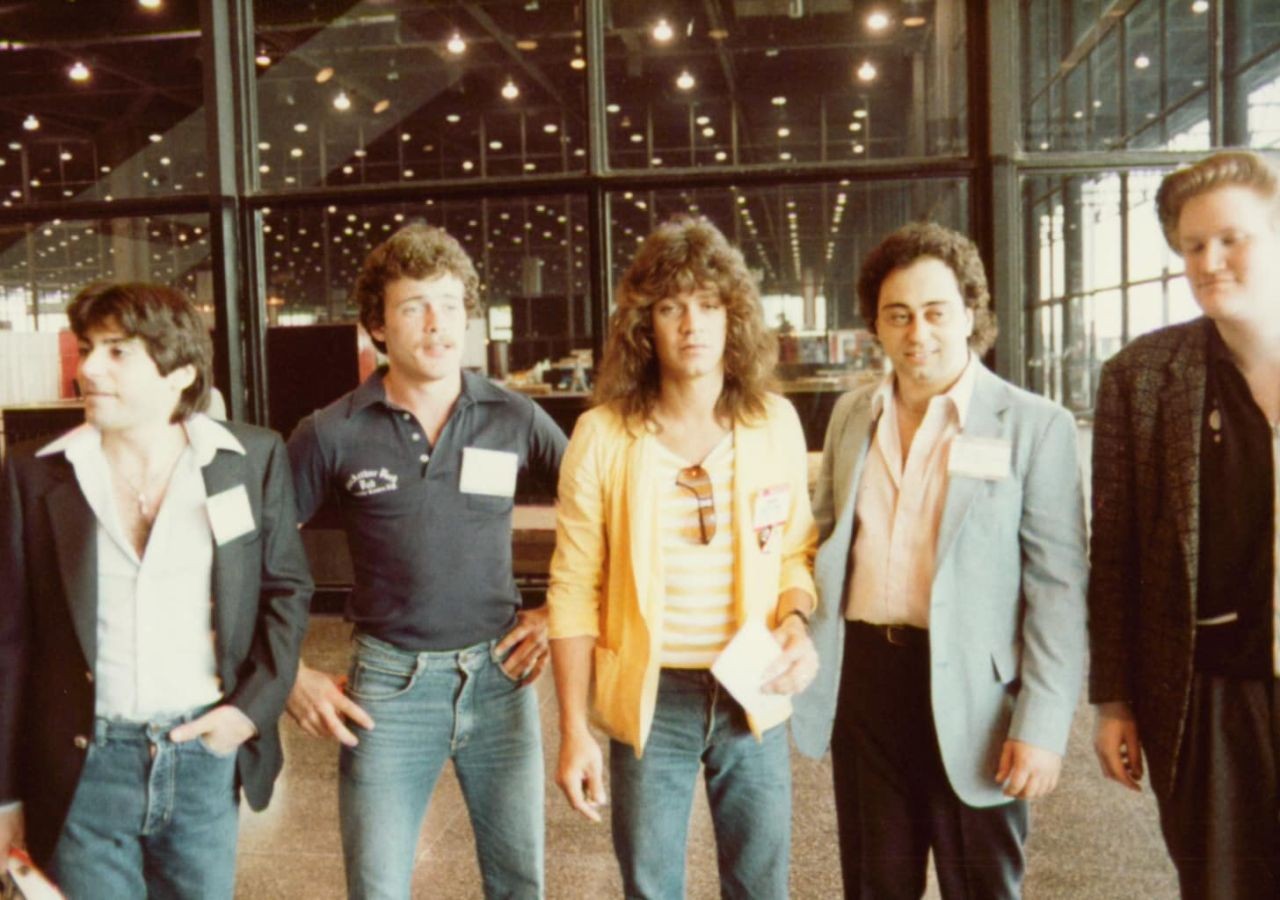
The Japanese MIDI Standards Committee (JMSC) is formed
Tokyo, Japan
June 29, 1983
Not surprisingly the Japanese were more organized and formalized in their approach to MIDI and associations.
The Japanese Electronic Music Industry Association (JEMIA, now AMEI, the Association of Musical Electronics Industries) had been formed in 1976 and was a professional association that included manufacturers like Yamaha, Roland, Kawai and Korg.
On February of 1983 just a month after the 1983 NAMM show, the Japanese formed the MIDI Standard Liaison Committee and later the same year changed the name to the Japan MIDI Standards Committee (JMSC).
Japan was viewing MIDI as a business strategy and not simply as a technical specification.
Compare this with the situation in the rest of the world where the IMA was struggling to keep up with the worldwide demand for information on MIDI and where the MIDI Manufacturers Association (driven strongly by Jeff Rona who worked for a Japanese company) was still 2 years away from becoming an established non profit trade association and registered company.
Bob Moog Keyboard Article
MIDI- What is it, what it means to you
July, 1983
The first person to do an indepth article about MIDI was Dr. Bob Moog in his July 1983 Keyboard Magazine article.




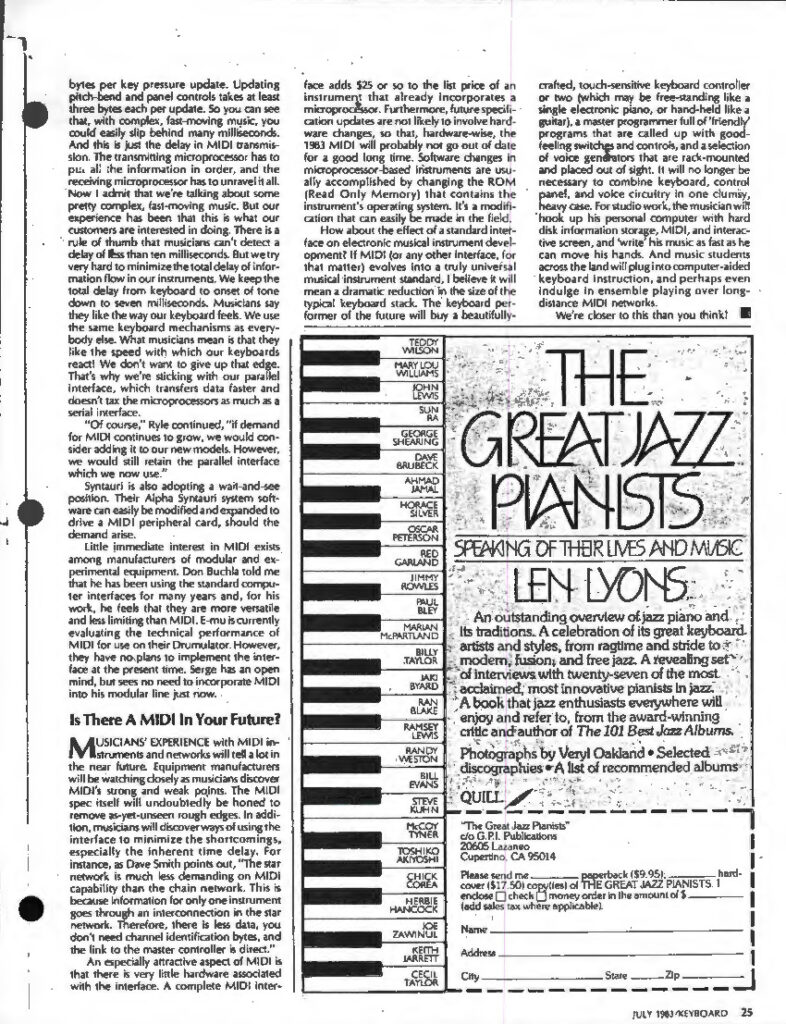

The tone of their answers ranged from forceful (when I talked to the head honchos of the smaller manufacturers) -to circumspect or downright evasive (when I talked to local representatives of the larger manufacturers).
On basis of their answers, I divided the manufacturers into three categories:
(a) those who now have, or are about to introduce products,
(b) those who will probably not show MIDI products in June, but who
actively working on MIDI-equipped designs
(c) those who have no firm plans to implement MIDI in forthcoming products:
Here is what I learned. Roland, Sequential Circuits, and Yamaha will be showing several MIDI-equipped products.
Digital Keyboards, Moog, and OctavePlateau are each showing a previously introduced instrument which they have equipped with a MIDI.
Sequential Circuits is also developing a MIDI interface card to plug into a Commodore 64 computer, which they plan to show in June.
Yamaha is showing their DX7 and DX9, two new polyphonic synthesizers with MIDI. The instruments employ Yamaha’s FM technology, and are therefore completely digital.
Yamaha has also developed MIDI-oriented software for the Apple II computer, which they will show at NAMM.
Among manufacturers who are planning to introduce MIDI products after the the 1984 NAMM show are Crumar, Korg, Linn, PAIA, and Passport Designs.

Dr Bob Moog
Keyboard Magazine, July 1983Furthermore, future specification updates are not likely to involve hardware changes, so that, hardware-wise, the 1983 MIDI will probably not go out of date for a good long time.
How about the effect of a standard interface on electronic musical instrument development?
If MIDI (or any other interface, for that matter) evolves into a truly universal musical instrument standard, I believe it will mean a dramatic reduction· in the size of the typical keyboard stack.
The keyboard performer of the future will buy a beautifully crafted, touch-sensitive keyboard controller or two (which may be free-standing like a single electronic piano, or hand-held like a guitar), a master programmer full of ‘friendly’ programs that are called up with good feeling switchs and controls, and a selection of voice generators that are rack-mounted and placed out of sight. It will no longer be necessary to combine keyboard, control panel, and voice circuitry in one clumsy, heavy case.
For studio work, the musician will hook up his personal computer with hard disk information storage, MIDI, and interactive screen, and ‘write’ his music as fast as he can move his hands.
And music students across the land will plug into computer-aided keyboard instruction, and perhaps even indulge in ensemble playing over long distance MIDI networks.
We’re closer to this than you think!

Dr Bob Moog
Keyboard Magazine, July 1983MIDI 1.0 Specification From August, 1983 Uncovered at YCA offices in April, 2018
In November of 2018 we uncovered some unique historical MIDI documents. These were discovered in a file cabinet at Yamaha Corporation of America’s (YCA) headquarters in Buena Park, California.
These documents pre-date the formation of the MIDI Manufacturers Association and give us a truly remarkable look into the the early development of MIDI. There were three key documents.
The first is a very early version of the MIDI 1.0 specification from August 1983.
We also uncovered two issues of the IMA bulletin- one from June 1985 and another from June 1987.
The early MIDI 1.0 specification is a very short 14 page document. Compare this to the 58 page MIDI 1.0 specification document published in 1995 which also included 7 pages of Appendixes pages and 13 pages of Tables.
The copyright of this early MIDI 1.0 specification is assigned to the International MIDI Association based in Sun Valley.
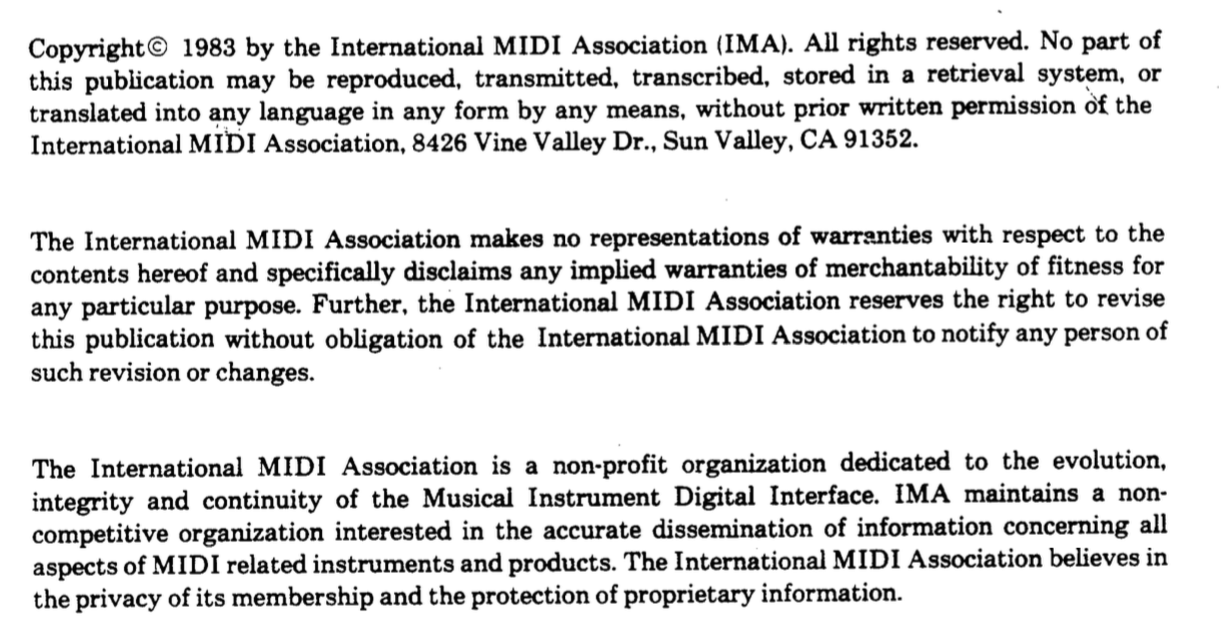
This document clearly shows that even in August of 1983 the MIDI specification was still in flux and had not been fully flushed out. For example, Continuous Controllers 64-95 are defined simply as Switches (On/Off).

This also shows that at this stage, there was clearly a desire for 14 bit resolution of continuous controllers in MIDI 1.0.
Here is a list of the original 14 companies that were involved with MIDI at the time.
Notice that both Big Briar (Bob Moog’s company after he left Moog) and Moog Music (owned at the time by Norlin) are listed. Many people underestimate Bob Moog’s role in MIDI gaining acceptance.
Also of note is the number fo companies that were working on computer interfaces and MIDI software at this time including Sequential Circuits, Octave/Plateau, Passport Designs, and Roland.

This version of the MIDI spec also featured a MIDI logo that was never used in later official specifications from the MIDI Manufacturers Association.
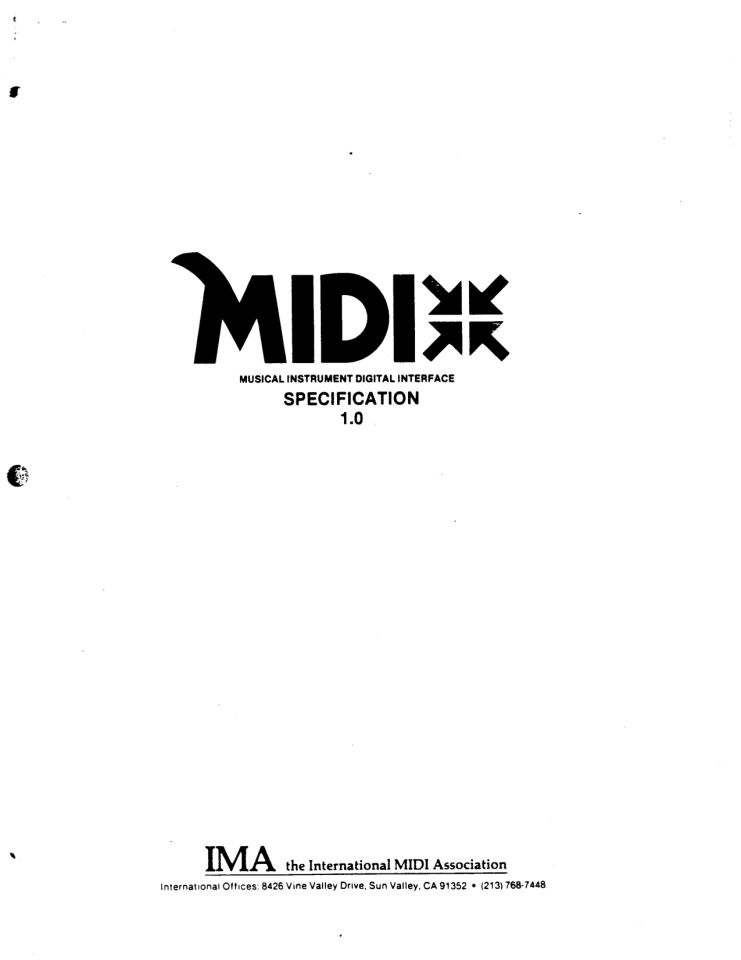
Here is the first communication to companies and people interested in MIDI from the International MIDI USer Group that soon became the International MIDI Association.
You can see how bold (and perhaps unrealistic) the IMUG’s goals were (for example setting up a testing lab to test all MIDI products before they were shipped to ensure that they were interoperable or keeping a database of every person who used MIDI).
It also offers a manufacturer’s membership.
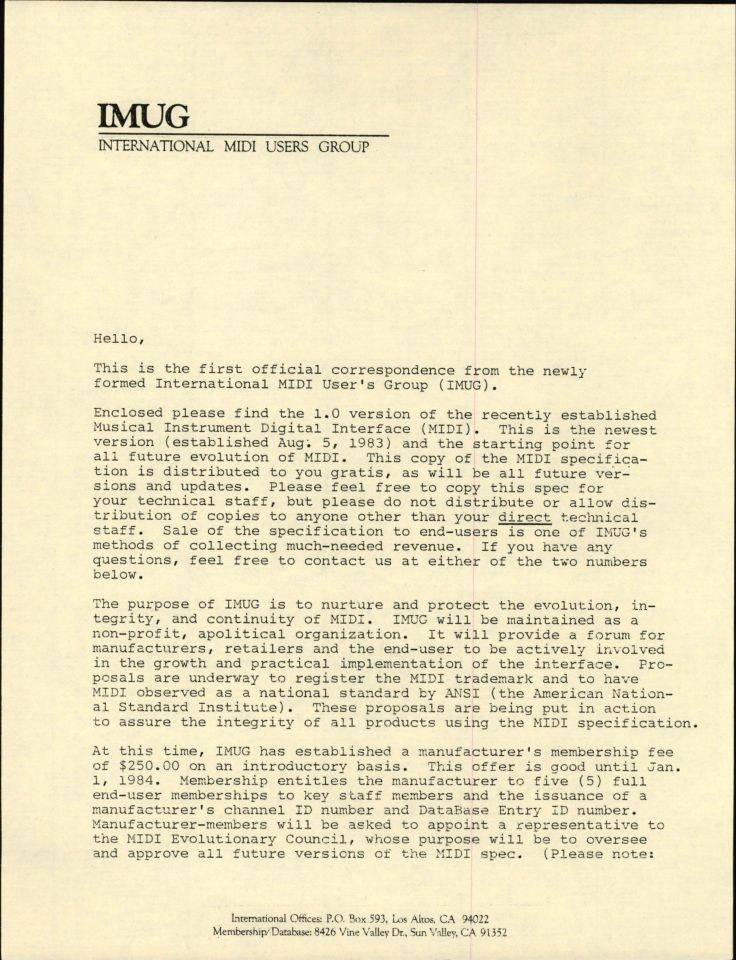


Ikutaro Kakehashi joins the IMA
Sept. 27, 1983

With this you can see that in September of 1983, there was still some confusion about who was in charge of MIDI in the rest of the world outside of Japan. But soon the newly formed Japanese MIDI Standards Committee would start to pressure IMA and non-Japanese companies to get there act together.
Communications between IMA and JMSC
October , 1983
In the days after the 1983 June NAMM show, there were a number of important communications between the International MIDI Association and the Japanese MIDI Standards Committee.
By October of 1983, JMSC had 28 corporate members and 24 individual members and was keeping them all informed about updates to the MIDI 1.0 specification.
Mitsuo Matsuki-san , Chair of the JMSC sent a letter to the IMA.
In particular, Matsuki-san expressed that the Japanese felt strongly that
- MIDI should remain open to the public
- That both the Japanese MIDI Association and the International MIDI organization should agree together on any changes to the specification
- The MIDI organization needs to rely on the individual manufacturers to be responsible for their implementations.
It’s interesting that more than 40 years later, MIDI still operates under the same fundamental principles.


On November 8th, 1983, the Japan MIDI Standard Committee (JMSC) followed up with more details.
In November of 1983, JMSC was granted a trademark on MIDI in the Japanese market.

Importantly, JMSC would not be open to end users, but focused on companies (software and hardware) that made MIDI products.
Second, it was determined that the people who contributed to MIDI from the different Japanese companies would all be volunteers “the staff appointed by each manufacturer to discuss various questions and problems are unpaid for their participation”.
This is another core principle of MIDI that continues today as The MIDI Association at its core is an all volunteer, non-profit organization.

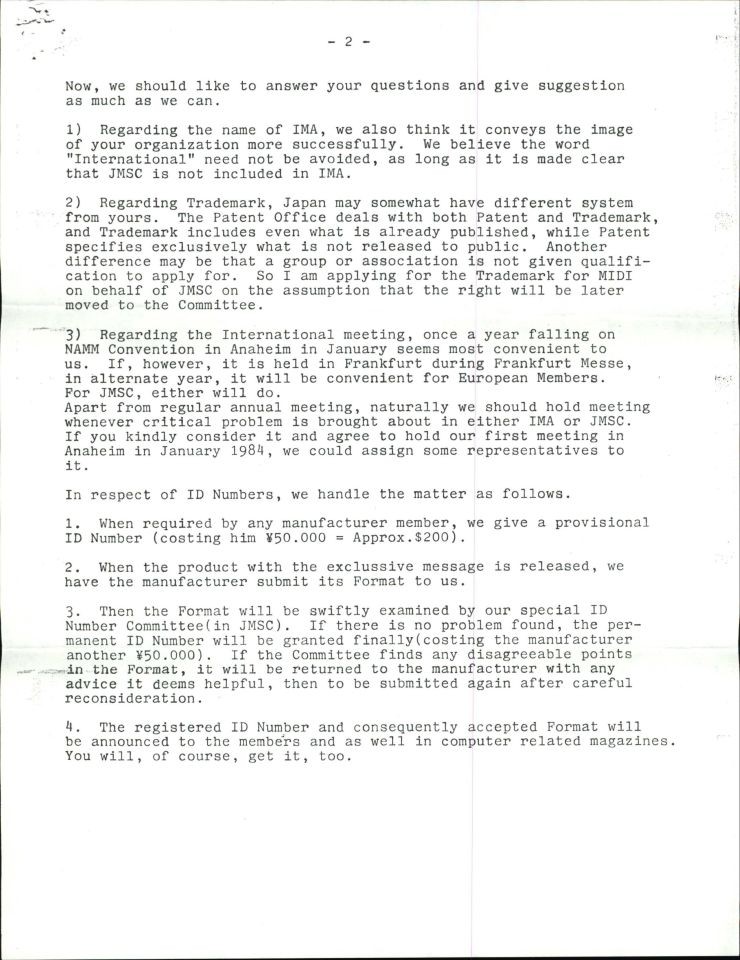
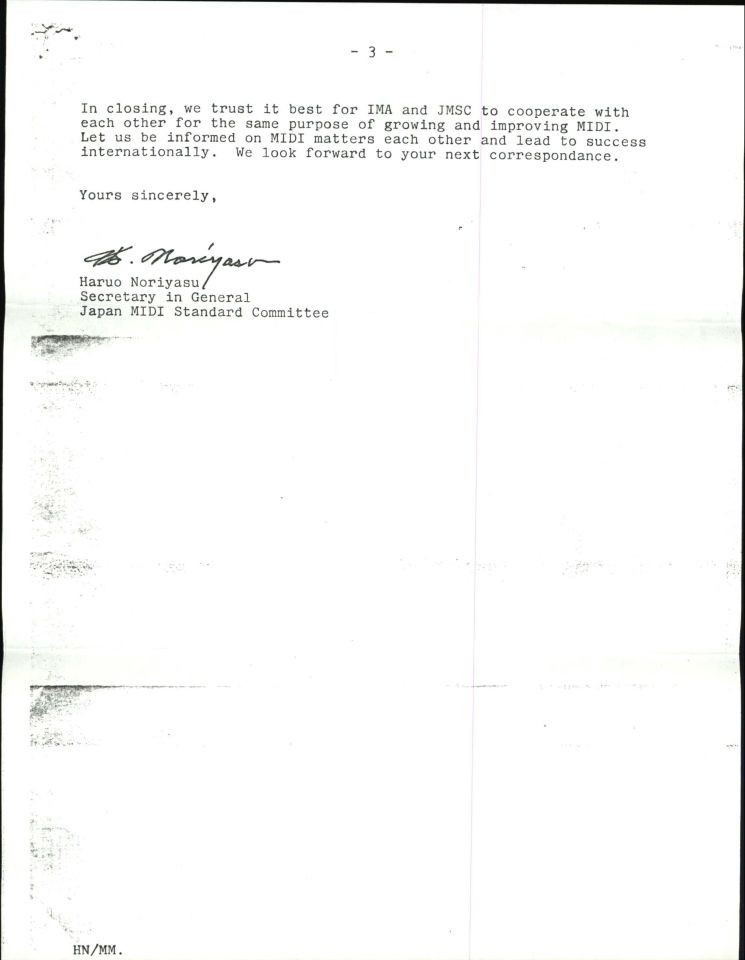
The IMA- Where is this whole thing going? We’re not quite sure.
December, 1983
As the IMA was dealing with communications with JMSC, they were also putting some some ambitious plans. But at least, the IMA was honest in their Membership brochure when they said “Where is this whole thing going? We’re not quite sure”.
The IMA laid out their plans in a brochure they prepared for the upcoming Winter NAMM show in January, 1984. IMA had a lot of ideas including: a MIDI Evolutionary Council (MEC), a MIDI Database, The IMA Network, and an annual convention of “all the MIDI-related products in one place at one time.”
- A MIDI Evolutionary Council (MEC)
- A MIDI Database of MIDI products
- A monthly Newsletter with application notes, product reviews and a what’s new section
- An IMA Network that included local meetups
- An annual convention of “all the MIDI-related products in one place at one time.”


The MIDI Evolutionary Committee
January 1984
Winter NAMM Show in Anaheim


In interviewing many people about that first tumultuous year of MIDI almost everyone would have to stop when asked about Roger Clay and say something like “Roger was a real character” or “Roger was good at promoting things (mostly himself)”.
Roger got involved in the IMA because he had been working on setting up user groups for the Prophet 5 and the Rhodes Chroma and when he heard about a user group for MIDI, he saw a big opportunity to get in front of a lot of people.
Roger was involved setting up IMA in 1983 , but left the organization in November of 1984.
No one we talked to knew what happened to Roger Clay after the IMA, but if anyone knows, please contact us at info@MIDI.org.

The International MIDI Association had put formed a MIDI Evolutionary Committee that included Anne Graham from Oberheim, Bob Moog (now at Big Briar) , Curt Simmons, Jim Smerdel from Yamaha, John Bowen from Sequential Circuits as well as Brian Vincik and Roger Clay from the IMA itself.
Apple and Lucas Films join the IMA
February, 1984

MIDI Soft’84
Two Day Event in Bay Area
May 24-25, 1984

MIDISOFT’84, to be held at the renown Mark Hopkins Hotel in San Francisco, California, will bring together in one place for the first time, the molders and shapers of music software and will offer an open forum for the discussion of standards and practices concerning this new phenomenon.
MIDISOFT’84’s main goal and purpose is to establish a MIDI Software Standards Board and to provide a introduction to Music Software and the MIDI phenomenon to the software developer and end-user alike.
Scheduled Speakers and Topics (confirmed with outlines):
Jaron Lanier (Software Author -“MOONDUST”)
“MIDI/Music Software and the Consumer Market”
Alan Marr (Software Developer, LUCASFILM, LTD)
“The Uses and Development of Icons and Glyphs in Music Software”
Dr. Charles Goldfarb (Senior Analyst, IBM)
“Formats and Standardization Proposals for Musical Databases”
Robert Barkans (Documentation Consultant, DOCUPRO)
The International MIDI Association
What is interesting is that if you look closely there is no one from any of the Japanese companies at this meeting. It was certainly not because the Japanese were not interested in MIDI music music software. MLTA recipient Jeff Rona was already completely the MPU-401 which had been tasked with creating as soon as he joined Roland in 1982 and Yamaha was working on Apple II software.
Did the Americans who worked for the Japanese companies like Roland, Korg and Yamaha have an idea that things would soon change in regards to the IMA?

We found a pretty accurate contemporary summary of what happened at MIDIsoft’84 from the British Music Magazine “Electronics and Music Maker” from their November 1984 issue, a full 6 months AFTER the event happened.
Once again, communications were much slower back in the early 1980s.
At long last, some feedback on the two-day MIDIsoft event held back in May in a San Francisco hotel under the banner of the IMA (International MIDI Association).
Given that this wasn’t a free event ($35 for IMA members, $60 for non-members), the quoted attendance of 219 was pretty good. The major problem with this sort of umbrella event is that everything stands or falls on the support of the manufacturers, and unfortunately, Korg, Kurzweil, Oberheim, and E-mu were as far as the manufacturers’ conclave went.
And with the exception of Korg, all those names are of companies that have come late (Kurzweil and E-mu) or reluctantly (Oberheim) into the MIDI game.
Anyhow, what transpired from the various question-and-answer sessions over the two days was that:
(a) most of the attendees were there for serious software purposes
(b) much thought was being devoted to getting around the very obvious limitations of the MIDI standard (parallel ACIAs, use in conjunction with memory-mapped sound generators, and so on)
(c) many felt that they were being cold-shouldered by the manufacturers.
Curiously, most of the timetabled lectures were somewhat detached from the MIDI pure and simple.
For instance, Dr Gareth Loy gave a talk on software (running on a sizeable minicomputer) that has been developed at the Computer Audio Research Laboratory at the University of California in San Diego; Robert Barkan of DocuPro suggested how to write decent manuals; Dr Charles Goldfarb spoke on musical databases; and Alan Marrs from Lucas Films discussed the subject of glyphs and icons in the context of constructing film soundtracks with the infamous Audio Signal Processor.
All in all, a lot was said, a good deal was discussed, and plenty of confusion reigned about where things are going to go next.
Clearly, an unbiased arbiter of the MIDI standard is needed – and the IMA would seem to be in a good position to offer this role – but how do we go about convincing so many large and powerful manufacturers that we’re not just a bunch of jokers out to extract freebies and the like from gullible publicity departments?
Very difficult, I’d say.
What’s more, the situation is complicated by the fact that the big boys – Roland, Yamaha, Sequential Circuits – are planning their own meeting at the forthcoming NAMM convention, and of course, the IMA, haven’t been invited along.
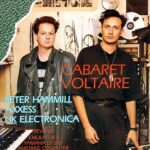
Electronics and Music Maker
November 1984 issueTurmoil in MIDI land
Keyboard Magazine
June, 1984
MIDI was developed in a very short period in two different places (Japan and the United States) separated by different languages and a large ocean in a time when there was no Internet and not even fax machines.
A whole lot of companies from different backgrounds in both software and hardware jumped on to MIDI very quickly in a computer industry that itself was still just getting started.
It really shouldn’t have surprised anyone that there were bumps in the road.
Not everyone implemented arpeggiators the same way. Some sent out the notes from the keyboard and some sent out the notes from the arpeggiator. There are inconsistencies in how Pitch Bend was implemented, and famously the DX7’s keyboard (one of the first MIDI instruments and one of the most successful) only went up to 100 in MIDI velocity so it sounded fine when played from its own keyboard, but could get pretty nasty when played from an external MIDI controller from another company.
All these issues and many more were pointed out in this June 1984 Keyboard Magazine article.
Notice the IMA ad with the strange MIDI logo from the translated document from August of 1983.
As you’ll see, there’s a lot of disagreement over what MIDI is and should be.
However, there’s also a lot of optimism mixed in with the gloom and doom pronouncements.
MIDI is starting to show up on instruments of every size and shape, and it doesn’t take a
fortune teller to know that it’s going to be with us for a long time to come.
Keyboard Magazine
1984 Turmoil In MIDi LandKeyboard Magazine
1984 Turmoil In MIDi Landof the International MIDI Association (IMA).
The IMA is a non-profit organization designed to disseminate information on the MIDI specification to end-users – the players who buy MIDI-equipped instruments. The organization is also supposed to help software designers get information on protocols for various instruments and help manufacturers stay in touch with each other and keep up to date on all the implementations of MIDI.
However, some manufacturers aren’t cooperating with IMA. Some outright refuse to acknowlege its existence. Still others can’t understand why their colleagues are holding out.
Everybody professes to support the idea of and the need for such an organization, but no one we spoke to was willing to go on record to explain their reservations about the IMA or the apparent personality conflicts involved. Which is as it should be. It would be counter-productive to get tied up with gossip and innuendos that serve no purpose but to confuse the issue and make everyone look petty.
Nevertheless, the fact remains that for one reason or another, IMA is having some trouble getting all the manufacturers to pull together as a team.
Keyboard Magazine
1984 Turmoil In MIDi LandBut in order for the manufacturers to do that there has to be some group in place that is
willing to work on these problems, and by and large, my experience so far with the engineering group from manufacturing is that (1) they’re engineers, not software developers, and (2)everybody’s too busy building their next product.
They haven’t got time for MIDI. Okay, fine. Who can do it? Who has authority? And will they allow those questions to be answered? That’s all part of the politics of MIDI. Those things should be addressed. There should be a group in place to do that. If that doesn’t happen, then we’re going to have significant problems.
One of the other things that we’re calling to arms on is a splitting off for actual specification purposes of the hardware and software aspects of the spec.
I talked with a couple of people about the specs, and there may be three actual specifications that should come out, if it ever goes to standardization: a hardware spec, a software spec, and a spec for formatting data information.
I intend to give a talk about it at MIDIsoft [a conference about MIDI software scheduled for May in San Francisco]. It’s one of the things tha we’re going to suggest, or recommend, since the IMA is a communication and information exchange. And that’s what MIDI is all about.
Keyboard Magazine
1984 Turmoil In MIDi LandHow much did the spec change at that point?
Dave Smith
The Japanese had a lot of good ideas, and we made a lot of changes in the spec based
on them. But it still stayed a high-speed serial interface. It was Roland’s idea to put in the
optical isolation; it was their idea to make it 7-bit status. It’s real hard to say who did what
beyond that because it was a true cooperative effort between the five companies.
That was when we sat down with the five companies- Roland, Yamaha, Korg, Kawai, and Sequential -and came up with what we called the 1.0 spec. This was in Japan in August 1983. That’s the version that we released.
Keyboard Magazine
1984 Turmoil In MIDi LandDoes Roland have plans to get together with other manufacturers to iron out problems between instruments?
Jim Mothersbaugh -Roland US
Yeah. Yamaha, Sequential, and Roland will be getting together shortly to work out
the last of the bugs in their systems. Basically, the technique that we’ve found works in Japan will probably prove to be most productive here.
That’s where the manufacturers get together and confront each other, deal with each other, and analyze the situation to see what the best way to cure the problems is.
You’ve got to expect this kind of thing. It happens with virtually any new concept.
Everybody’s producing new products so fast that at this stage of the game there are bound to be jams in the traffic.
Keyboard Magazine
Are there any problems in communicating with other companies?
Jim Mothersbaugh -Roland US
I don’t think so. In Japan, the communications link was developed a few years ago, so it’s a little easier there.
Here, the American companies are just now learning how to do that. A couple of years ago, you would have never thought of seeing Oberheim and Roland sitting down and talking about interfacing products. It would have been totally ludicrous. It’s a reality today. That’s the exciting part for me.
Keyboard Magazine
1984 Turmoil In MIDi LandWhat would an updated MIDI 2.0 spec do to all the—instruments currently available?
Ralph Phraner -independent software consultant
It wouldn’t have to have any noticeable effect. What you’d do is have the most capable device ask all the others in the chain if they’re capable of handling a megabit baudrate or whatever.
They’d do that by manufacturer ID number or whatever code was decided on. All the instruments in the chain would answer back, and a unit that couldn’tdo a megabit might answer back, “No, I can only do 31.25k.” Then the most capable unit would say, “Okay everybody, we’re going to talk at 31.25k now.” If all the devices answered back, “Yes, we’re capable of a megabit” then they would all switch into enhance mode and be able to transmit at the higher bandwidth.
I would see that as a way to move smoothly from the equipment out there now to equipment with an enhanced standard. But it’s all in the hands of the manufacturers now. We’ll really have to wait and see what happens.
Keyboard Magazine
1984 Turmoil In MIDi LandMIDI Manufacturers Association Meeting
Winter NAMM
Anaheim, California
Feb 1-3 1985
At the next NAMM show in February of 1985, the major manufacturers got together and decided on a strategy to make sure that MIDI would be stable and could grow over the next decades.
At that meeting, Jeff Rona stepped up to volunteer to put together a MIDI Manufacturers Association. The new MMA and the existing IMA came to an agreement about how they would work together.
This arrangement between the MMA and IMA was probably made easier by the fact that Roger Clay who had been somewhat antagonistic to the manufacturers (as seen in his comments in the Turmoil in MIDI Land article) was no longer with the IMA.
First Public Meeting of the MIDI Manufacturers Association
Summer NAMM
New Orleans, Louisiana
June 24, 1985
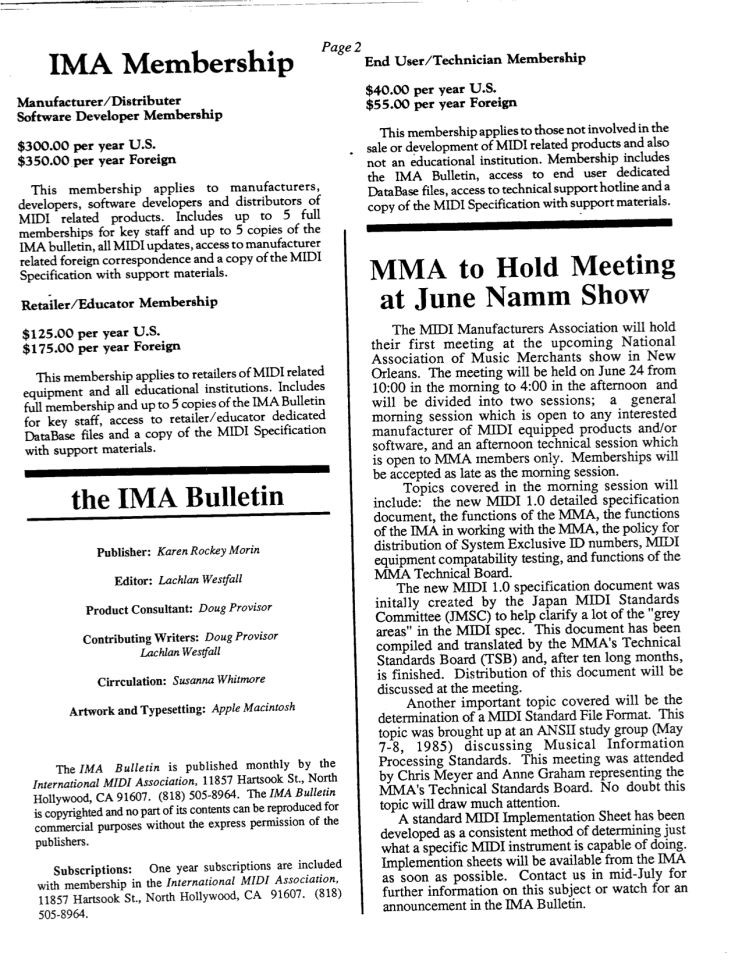
2025 MTLA recipient Jeff Rona, the first President of the MIDI Association documents the details of that meeting very well in his article “MIDI from the Inside”.
He did get one small detail mixed up.
He got the place right (who could forget the heat in New Orleans that NAMM show), but the year is incorrect as the NAMM show was only held in New Orleans once and that was in 1985 (not 1983).
What’s most interesting the June 1985 IMA announcement is that announces a “new MIDI 1.0 specification” that was authored by the Japan MIDI Standards Committee and translated from the Japanese by the MMA, and the creation of the standardized MIDI implementation chart.
This is a full two years AFTER the initial public demo in January of 1983 and the first version of the MIDI spec was distributed by the IMA.
The MIDI Manufacturers Association (now DBA The MIDI Association) has always been supported by corporate member companies who pay annual dues to the trade association.
But the IMA’s only source of revenue was “selling” the specification which was soon very widely available.
The International MIDI Association eventually closed its doors and there was no place for users of MIDI to congregate and discuss MIDI for many years.
Then in 2016, a public facing website was created by The MIDI Association. We started to allow individuals who use MIDI to join The MIDI Association by simply registering with an email address
We started with literally no individual members in 2016 and now have over 30,000 members who have joined for free, can discuss MIDI topics on the public forum and are able to download all the latest MIDI specifications.
We recently have been sending monthly MIDI Notes Newsletters to keep people informed about the latest developments in MIDI, inform people of new MIDI Association corporate members and update people on the work of our special interest groups for MIDI In Music Education, Game Audio (IASIG) amd Music Accessibility. We are currently working on a database of MIDI 2.0 products which we plan to debut at the 2025 NAMM show.
So although the International MIDI Association does not exist as an entity anymore, many of their dreams are still alive today.
It seems that there has always been a need for the people who work, play and create with MIDI to have a way stay in touch with the MIDI companies who push the specifications forward.
We encourage our MIDI Association individual members to express their opinions about where MIDI 2.0 should go in the future.